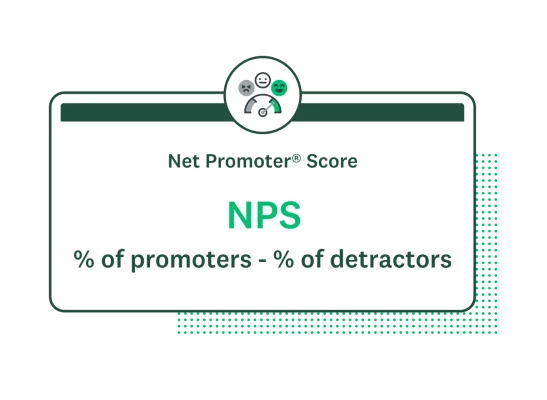Net Promoter Score (NPS): definition, calculation, and best practices
Measure customer satisfaction with a Net Promoter Score survey. Learn how to calculate it, and get tips for creating an effective NPS survey.

The Net Promoter Score (NPS®) survey is an easy way for businesses to measure customer satisfaction and loyalty. Regularly tracking NPS helps monitor the impact of your customer experience (CX) strategies, so you know what's working for your business.
Millions of businesses worldwide use NPS as a core CX metric, making it a valuable benchmark.
What is the Net Promoter Score (NPS)?
Net Promoter Score is a metric that measures customer satisfaction and loyalty with one central NPS question: "How likely are you to recommend our product/service to a friend or colleague?"
Respondents will use a scale of 0 to 10 to indicate their likelihood of recommending your company. A rating of 0 means they're unlikely to recommend your business, while a rating of 10 means they're highly likely to recommend it to others.
Using the NPS framework, you can then classify customers into three categories based on their responses:
- Detractors (scores 0–6): These unhappy customers can hurt your brand through negative word-of-mouth.
- Passive (scores 7–8): These customers are satisfied but indifferent; they might even shop with your competitors.
- Promoters (scores 9–10): These loyal customers will likely refer you to others.
You can use the NPS formula to generate your NPS score on a scale of -100 to 100, with a higher number indicating high customer loyalty and satisfaction.
Why is Net Promoter Score important?
- NPS measures customer loyalty. At its core, NPS shows your business how loyal your customers are. Loyal customers contribute to everything from improved sales to higher retention to happier employees.
- NPS benchmarks your progress. You can compare your NPS survey scores against previous internal results or against other companies to see how you compare over time. Track whether you’re reaching industry averages or surpassing them.
- NPS is simple and quick. One question is all it takes to determine your Net Promoter Score. With our Net Promoter Score template, you can set up and send your survey in minutes.
- NPS identifies promoters, detractors, and passives. Classifying your customer base into these three categories will help you create targeted feedback initiatives in the future.
- NPS is easy to understand. Scored from -100 to 100, NPS is an easy metric to understand, making it useful when communicating customer sentiment to stakeholders and business leaders.
- NPS is repeatable. By collecting NPS data regularly, you can track how your customer experience strategy impacts customer satisfaction.
Conducting NPS surveys will allow your business to better understand customers' feelings about your customer experience efforts. You can create an actionable plan to enhance your customer experiences by conducting follow-ups with less satisfied segments.
Related: Why use NPS?
How to calculate Net Promoter Score?
To calculate your NPS, subtract the total percentage of detractors from the total percentage of promoters (% of promoters - % of detractors.)
You’ll get a percentage ranging from -100% to 100%. This result is your NPS.

Here’s our step-by-step breakdown:
- Send your NPS survey to your target demographic.
- Count the responses that fall into the promoter category (scores of 9-10) and the number of detractors (scores of 0-6). Ignore the passives; they’re not included in the NPS calculation because they don’t impact customer loyalty directly.
- Find the percentage of promoters and detractors: divide the number of promoters and detractors by the total responses, then multiply by 100.
- Subtract the percentage of detractors from the percentage of promoters.
Imagine you received 200 responses to your NPS survey:
- 20 responses were in the 0–6 range (detractors.)
- 40 responses were in the 7–8 range (passives.)
- 140 responses were in the 9–10 range (promoters.)
To determine the percentage of your detractors and promoters, divide each number by the total responses, then multiply the result by 100.
- 10% are detractors (20/200 = 0.1 x 100 = 10)
- 70% are promoters (140/200 = 0.7 x 100 = 70)
- Subtract 10% (detractors) from 70% (promoters). Your result is 60%.
Since a Net Promoter Score always appears as an integer and not a percentage, your NPS is 60.
Calculating NPS for a small group is easy but can get complex as your survey size increases. With SurveyMonkey's NPS template, the built-in NPS calculator ensures 100% accurate results faster.

NPS scale: promoters, detractors, and passives
Understanding promoters, detractors, and passives is central to calculating your Net Promoter Score. Each group fulfills a unique role in your business, making these classifications important for customer feedback.
Promoters
The NPS framework categorizes customers who respond with a 9 or 10 as promoters, representing the most satisfied customers likely to recommend your business due to their numerous positive experiences with your brand.
Sending additional feedback requests to these customers can show you what you’re doing well as a business.
Detractors
Any customer that responds 0-6 on the NPS survey is a detractor. Detractors are dissatisfied customers who are unlikely to recommend your business to a friend or colleague.
These customers have had negative experiences with your brand. You might receive a negative social review from these customers or see them churn soon.
Sending follow-up feedback requests to these customers can show you how you could improve your customer experience and turn detractors into promoters.
Passives
Passives are customers that score 7 or 8 on the NPS scale. These middle-of-the-road customers don’t love your business but haven’t had negative experiences. They typically won’t recommend your company but are happy enough with your products or services.
Don’t overlook this group; they can enhance your customer experience strategy. Collecting and acting on feedback from passives can help transform them into promoters and improve your overall customer experience.
What is a good Net Promoter Score?
A good NPS score indicates that your customers are generally delighted with your business and have a good perception of your brand.
The optimal NPS score for your business will vary depending on its industry. For example, a good NPS score would be around +50 for a professional services or consumer goods company. However, a good NPS score comes in at +40 in the technology market.
Generally speaking, if your NPS score is 25 or below, your customers might not be satisfied with your brand. It’s a good idea to collect more feedback to pinpoint your customers’ sentiments.
What is a high Net Promoter Score?
A high NPS score indicates that your customers are generally satisfied with your company and that you consistently deliver products and services that they love.
For benchmarking purposes, a high NPS score for professional services and consumer goods is +72. For technology, a great NPS score is around +64. If your score resembles these or is even higher, you have a high NPS score, which suggests that your customers love your brand.
Again, NPS benchmarking will depend on many factors, including your industry. To accurately benchmark your company, track your NPS score over time to determine improvement.
NPS vs. CSAT vs. CES
Net Promoter Score, Customer Satisfaction Score (CSAT), and Customer Effort Score (CES) are three metrics that reveal different aspects of your overall customer experience. While they include distinct features, they all work together to give you a well-rounded view of your business health.
As we’ve discussed, the NPS is a general measurement of customer loyalty. The NPS survey is great for quickly and accurately understanding customers' satisfaction with your business.
The CSAT score measures customer satisfaction with a specific part of your business, such as a product, checkout process, or customer support. It also measures how well you meet customer expectations for that aspect of their experience.
CES quantifies how easily your customers can complete specific actions with your business. SurveyMonkey research suggests that 91% of customers will recommend a company with which they have a positive, low-effort experience.
While NPS generally measures customer satisfaction, CSAT and CES allow you to examine the specifics of how happy customers are with your products, services, and interactions.

How to conduct NPS surveys: Best practices for success
Now you know how powerful NPS surveys can be at enhancing customer experiences and boosting customer loyalty, it’s time to conduct your own. Here are our best practices for success when conducting an NPS survey:
Use follow-up questions
Part of what makes the NPS survey so effective is that it's easy for customers to respond. Since it only has one question, it only takes a few seconds to complete.
However, the NPS main question only indicates whether customers are satisfied with your business; it does not provide insight into the reasons behind the scores. If you want more detailed information, it's a good idea to supplement the NPS survey with optional follow-up questions.
Include a mix of qualitative, open-ended questions that allow customers to share their sentiments in a comment box. A follow-up question could be as simple as, “Why did you give the score above?”
This will give customers the opportunity to add extra information that will provide context for their rating. Make sure to leave these as optional, as mandatory questions can take more time to complete and not everyone will want to give open-ended feedback.
Related: Transactional NPS vs. relational NPS
Consistently track NPS
Running your NPS survey to get your initial score gives you an idea of your current customer loyalty. NPS is even more effective when you analyze scores from different periods.
Of course, you can continually benchmark your NPS against other companies in your industry to give you a good idea of where you stand. However, monitoring how your NPS score changes over time is even more effective.
Your business should consistently send out NPS surveys at least once every quarter. A consistent stream of NPS data allows your business to demonstrate the effect of all your teams' customer experience improvements.
Send an NPS email to collect more responses
NPS emails embed the NPS question into the body of the email. Once respondents select a rating in the email, a link to the survey opens in another window, allowing the respondent to complete the rest of your survey.

An NPS email has proven effective for collecting more responses. Our research team found that simply embedding a question into the body of the email invitation increases the survey’s response rate by 22% and its completion rate by 19%.
Use an NPS email to get more quality data as you collect your NPS on a consistent cadence.
Create an action plan
Based on the findings of your NPS (or any additional feedback you collect), you can create an action plan to enhance your customer experience.
Use the feedback you collect from your NPS scores to build a customer experience strategy plan that satisfies more customers. As you implement their feedback, follow up with customers to show them you’re listening to their comments, which can win you even more promoters.
Applying your findings will help to improve your business processes. As these evolve, you’ll satisfy more customers and reach higher NPS scores.
Related video: Top NPS tips and common mistakes
Create NPS surveys with SurveyMonkey
The Net Promoter Score (NPS) has become a global customer experience metric. It offers an easy, fast, and actionable way to measure customer loyalty, making it a vital metric to monitor.
With SurveyMonkey, you can instantly create effective NPS surveys and share them with your customers. Learn how SurveyMonkey’s all-in-one platform helps build and deploy NPS surveys that measure your Net Promoter Score.
Discover more resources

Customer satisfaction survey templates
Explore our customer satisfaction survey templates to rapidly collect data, identify pain points, and improve your customer experience.

See how Aptive gathers critical Veteran insights
Discover how Aptive uses SurveyMonkey to collect critical Veteran insights to improve federal government services and Veteran experiences.

Hornblower enhances global customer experiences
Discover how Hornblower uses SurveyMonkey and powerful AI to make the most of NPS data, collect customer insights, and improve customer experiences.

Ultimate Customer Satisfaction Guide: 8 Tactics to Improve
What is customer satisfaction? Learn what it is, how to measure customer satisfaction, and 8 strategies for business success with this complete guide.
See how SurveyMonkey can power your curiosity
NPS, Net Promoter & Net Promoter Score are registered trademarks of Satmetrix Systems, Inc., Bain & Company and Fred Reichheld.